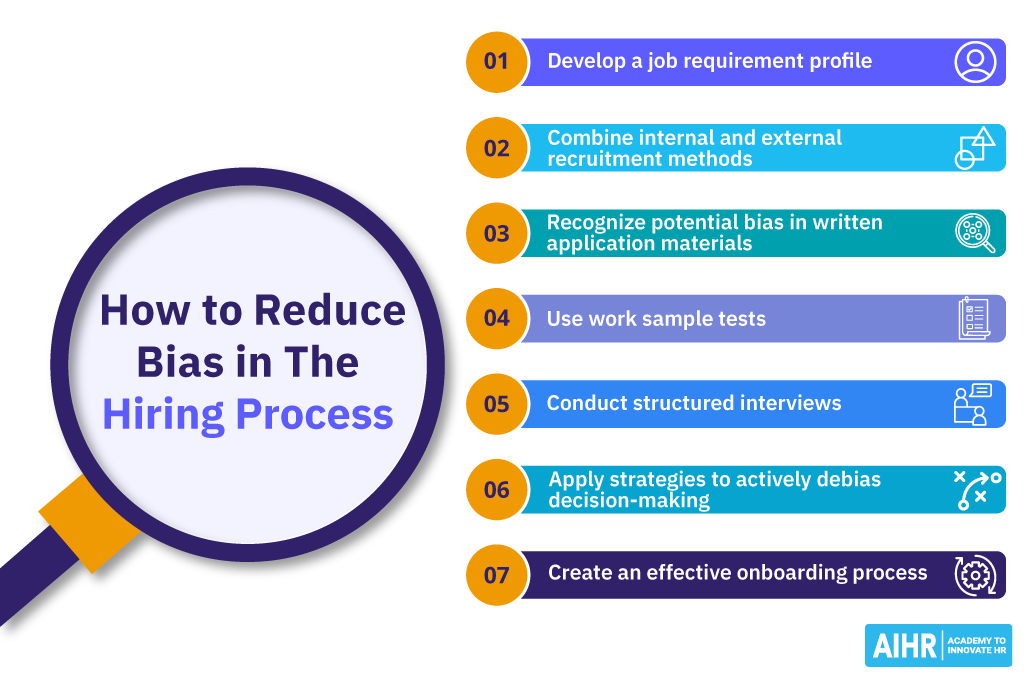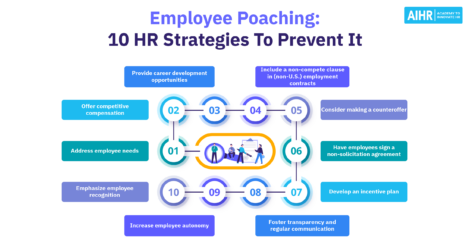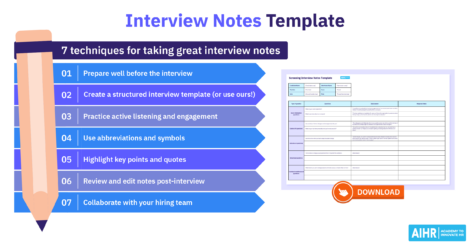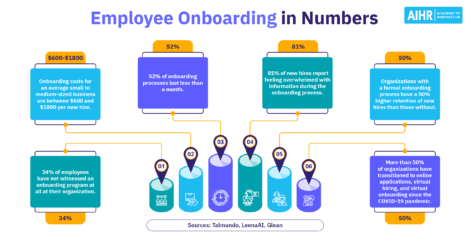How To Reduce Bias in the Hiring Process: 7 Steps

Let’s start with a short riddle. Imagine a father accompanying his son to a job interview at a well-known stock exchange company. As they pull into the company’s parking lot, the son’s cell phone rings. It’s the CEO on the line, saying: “I cannot interview you myself, you’re my son!” After the call, the son turns to his father, who is seated next to him in the car. How is this possible? Before reading further, take a moment to ponder this riddle.
Many might guess that the son has two fathers or is adopted – both reasonable assumptions. Yet, there’s a simpler answer often overlooked, according to Boston University research featuring a similar riddle: the CEO could be the son’s mother.
This riddle highlights how easily we succumb to gender bias, forming preconceived notions about certain roles, such as CEOs typically being male. Breaking free from these common unconscious biases is a challenge.
In this blog, we’ll explore how to reduce bias in the hiring process.
Contents
Common biases in the hiring process
7 steps to reduce bias in the hiring process
Common biases in the hiring process
People are often unwittingly influenced by numerous biases. These biases, largely unconscious, help people manage the vast amount of information constantly coming their way. They help organize and navigate complex situations, making them useful in some situations. However, these biases can also lead to detrimental outcomes.
Overlooking qualified candidates due to preconceived notions rather than assessing them based on their merits and suitability for the role undoubtedly has a negative impact on the organization. To put it briefly, bias in recruitment can result in a less diverse workforce, potentially limiting creativity, innovation, and overall business performance.
Let’s take a look at common biases in the hiring process.
- Confirmation bias: Confirmation bias is when people trust information that supports what they already believe while ignoring information that contradicts these beliefs. For example, HR managers may pay attention to information that boosts the chances of a preferred candidate – perhaps someone they already know and like – inadvertently overlooking equally qualified but less familiar candidates.
- Attraction bias: Perceiving attractive people as more competent, intelligent, and likable.
- Contrast effect: If a candidate is excellent, the next candidate might be considered worse. If a candidate is unqualified, the hiring panel might see the very same next candidate as better.
- Primacy- and recency effects: People remember information they receive either at the beginning or at the end of an interview better. Moreover, candidates in the final interview slot are more likely to be hired.
- Similarity effect: Also known as affinity bias, it refers to situations when hiring managers prefer candidates who are like them.
Stereotypes, which are assumptions about different groups of people, also have a considerable influence on the personnel selection process.
They can be based on various characteristics, such as gender, age, nationality, education, and socioeconomic status. These stereotypes skew how hiring managers evaluate and perceive a candidate’s suitability for a role. For instance, women might be seen as more fitting for roles requiring empathy and relationship-building, while men might be viewed as more suitable for competitive and leadership roles.
When faced with uncertainty and ambiguity, people often rely on stereotypes to fill in the blanks, especially when lacking complete information about a candidate. That’s when they resort to making assumptions based on the candidate’s visible characteristics, such as gender, age, or ethnicity.
By professionalizing and standardizing the employee recruitment and selection process, organizations can reduce these biases, thereby increasing the likelihood of hiring the most suitable candidates.
7 steps to reduce bias in the hiring process
Reducing bias in the hiring process requires a structured approach to recruitment and selection at your organization. You need to tackle bias in each step of your hiring process to hire the right people for your open positions.
Let’s get started.
1. Developing a requirement profile

The first step in streamlining the hiring process is developing a requirement profile for the job.
Ask yourself the following questions: Who are you looking for? Which skills and characteristics are needed to succeed in this specific job?
Organizations tend to search for a perfect candidate, someone who is good at everything and brings as many skills as possible. However, such an ideal person hardly exists. Instead, HR should take a step back and start by looking at the skills and characteristics necessary for this specific job.
A successful team manager might need other skills than a successful project manager. If HR practitioners and hiring managers don’t consider the requirements for each specific job, they end up looking for the same candidate profile.
Using the critical incident technique
The critical incident technique is useful for determining the characteristics needed for a job. It involves consulting current employees in similar roles about success-critical situations. Success-critical means that how well an employee does in the situation eventually determines if they succeed or fail in the job.
For a team assistant position, making copies might not be a situation in which behavior distinguishes between success and failure. However, organizing a high-quality caterer for a last-minute team gathering may well do so.
Work with the hiring manager to compile a list of success-critical situations. Then, pinpoint which specific behaviors make an employee successful rather than unsuccessful.
Once you’ve identified successful behaviors, you can determine which skills and characteristics employees need to show these behaviors. The aim should be to develop about eight to ten skills or characteristics.
Following this process allows HR to take a step back, establishing the skills and characteristics needed to succeed in a specific job rather than in general.
This profile not only guides the hiring and selection process but can also be adapted for similar roles, recognizing that different positions require distinct skill sets.
2. Combining internal and external recruitment methods
Once you’ve created the requirement profile, you can think about how to reach candidates. Specifically, the focus is on reaching candidates who may be a good fit for the job based on these requirements.
A balanced approach combining internal, referral-based, and external recruitment methods is often the most effective.
Internal and referral recruitment
Internal recruitment means reaching candidates from within the company, while referrals are about tapping into the personal connections of the hiring team and existing employees.
These methods typically lead to more qualified applicants. In addition, candidates have more information about the position and a more realistic idea of what the work environment will look like. They can better estimate their fit with the job and organization, making them more likely to accept the job offer.
However, only using these recruitment methods means that underrepresented groups are reached less. It also has the risk of preferring internally recruited people despite poorer fit due to the similarity and confirmation biases described above.
Internal and referral recruitment may ultimately result in more homogeneous teams with lower innovation capacity.
External recruitment
External recruitment uses conventional methods of attracting candidates like job postings or career fairs. It can create greater diversity in the candidate pool.
Job advertisements play a key role in external recruitment. They are often the only source of information about the advertised position, impacting how attractive an organization for candidates as an employer.
Job ads also greatly influence candidates’ intentions to apply. Many organizations underestimate this. They use standard descriptions in their job ads, and they do not include much specific information about the job.
However, advertisements that include more information increase the attractiveness of an organization. HR practitioners should use the requirement profile to create detailed and specific job ads, explaining why each skill is important for the role.
Men and women may react differently to job ads. Research shows that women apply to 20% fewer jobs than men and are also less likely to apply for a role after viewing the job ad. So, if done wrong, your job ads can lead to homogenous candidate pools and lower chances of hiring a diverse team.
One of the reasons for the different reactions is stereotypes or biases in the job postings, such as gender-stereotypical wording. For instance, if a management job ad uses masculine-coded words like “dominant,” “risk-taking,” or “competitive”, women might be less interested in applying.
To prevent this, HR can choose to highlight other aspects of the exact same job. For example, if the management job ad uses words like “communicative,” “social,” or “teamwork,” men are generally not affected by the wording.
Adverse consequences of stereotypical language tend to occur when the job ads focus mostly on the required characteristics. They are less likely to happen if the postings mention required behaviors. For example, you can say “you can come up with creative solutions” rather than “you are creative”.
Pictures in job ads also matter. When homogeneous teams are pictured, candidates from underrepresented groups can see less of a fit and are not interested. Both stereotypical wording and pictures of homogeneous teams signal that there’s little diversity within the team.
Candidates can be hesitant to enter such an organization. They may assume they’d become a token member and, thus, anticipate not belonging there or being treated negatively. To prevent such assumptions, HR should check recruitment advertisements for biases. They can utilize online tools to uncover gendered language or get feedback on the ads from various people.
3. Recognizing potential bias in written application materials
Common written materials in the hiring process include candidate resumes, cover letters, and letters of recommendation.
Some candidates opt to include profile pictures in their resumes, or HR can view their Linkedin profiles. Candidate pictures hold information about attractiveness and charisma. Despite the best intentions to focus on candidate skills, attraction bias can easily creep in.
Letters of recommendation can also be biased. For instance, some studies have found that women receive letters with fewer excellence-related formulations.
What’s more, there’s no widely shared standard for writing recommendation letters, and there are extensive differences among countries, cultures, and companies in how they write these letters. On top of that, managers differ in their letter-writing skills and motivation.
Overall, letters of recommendation are very difficult to decode. Ideally, they are not given too much weight.
It is best to use a rule of thumb when it comes to written application materials: When in doubt, the candidate goes to the next round. If you think too many candidates would go on to the interview, add an extra selection round, like a 15-minute phone or online screening interview with all candidates. Then, you can decide based on this extra round instead of only on the written materials.
4. Using work sample tests
Work sample tests have significant predictive power in determining whether a candidate would perform well in the job. They aim to determine whether candidates have the necessary knowledge or skills or the potential to acquire these.
Particularly effective for measurable knowledge and practical skills, work samples should be tailored to assess specific abilities outlined in the job’s requirement profile. To do so, HR managers can consider the following questions:
- Which skills do we want to assess in a work sample test?
- Which methods do we want to use to assess these skills?
The most suitable type of work sample test will depend on the position. Below are some common examples of work samples.
Before or after the interview, you could ask the candidate to:
- Write a two-pager with ideas regarding a project (e.g., to test writing skills or creativity)
- Provide feedback on an external communication or organizational website (e.g., to test critical thinking or PR skills)
- Come up with a project schedule and list of external stakeholders to consider (e.g., to test planning skills).
During the interview, you could ask the candidate:
- To present ideas regarding a project (e.g., to test presentation skills or creativity)
- A question in a foreign language (to test foreign language skills)
- To type an invitation letter to an external guest (e.g., to test organizational or communication skills).
5. Conducting structured interviews
The job interview serves several important purposes, including assessing both professional and personal skills, forming a personal impression of the candidate, and understanding their specific needs.
The most effective interviews are structured and partially standardized. This approach begins with HR crafting an interview guide with specific questions tailored to the job’s requirement profile. These questions, asked consistently across all candidates, help in fairly evaluating each individual against the same criteria.
Ideally, the development of the interview questions is a collaborative effort of HR, hiring managers, and other interviewers. First, each participant proposes questions based on the requirement profile. Second, in a short group discussion, the most relevant questions are selected and brought into a logical order.
Effective questions are formulated in a way that they refer to concrete behavior and distinct situations. They should only address a single circumstance and be as short as possible. Make sure to phrase the questions in a neutral, non-suggestive manner, avoiding any cues that might lead candidates to guess an ‘ideal’ answer.
The following two types of questions will help you conduct a comprehensive assessment of your candidates:
Biography-based questions Situation-based questions Past behavior is an excellent predictor of future behavior. By asking candidates about how they handled situations in the past, interviewers can infer how they might handle similar situations in the future job.
Ideally, the first question is formulated quite openly, and follow-up questions relate back to the situation.Some situations that the candidate has not experienced in the past might emerge in the new position. Situation-based questions can capture ideal behavior. The candidate is asked to imagine themselves in common and success-critical job situations.
When formulating these questions, focus on the success-critical situations from the requirement profile.Examples Examples • Question on conflict management skills:
Is there a situation where you faced a conflict with your team? What did you do? What was the outcome?
• Question on stress management skills:
Can you think back to a time when you had high work pressure? Please outline how you dealt with it.
• Question on conscientiousness/planning skills:
How did you chronologically structure your last project? How did you organize yourself?• Question on self-motivation and conscientiousness:
Imagine that you are working on an important task, which is lengthy and monotonous but at the same time requires high attention and diligence. How do you make sure that you get the task done with high-quality standards but at the same time do not lose enthusiasm and interest in your job?
• Question on leadership skills:
Your task will be to take care of a project with two interns. How do you guarantee success, and what kind of barriers could possibly occur?
Here is an outline of a well-structured job interview:
- Start of conversation: Create a welcoming atmosphere. Engage in some short small talk. Introduce everyone on the hiring committee.
- Candidate self-introduction: Ask candidates to introduce themselves.
- Free conversation: Pick up on one or two things the candidate said during the self-introduction. Clarify questions about written materials.
- Choice of organization and position: Why did the candidate apply here? Where and why does the candidate see a fit?
- Biography-based questions: Think about which characteristics you would like to see. Consider how you can ask questions about whether the candidate has these characteristics.
- Practical information on position and organization: What will the candidate do (e.g., tasks, work with which groups/people, …)? What are the unique selling points of joining the company and team (e.g., skill development, work-life balance, city, dual career program…)?
- Situation-based questions: Consider how you can ask questions about whether the candidate has these characteristics.
- End of conversation: Ask what questions the candidate has. Inform them about the timeline or next steps of the process, and thank you for coming in.
Different interviewers will notice different aspects of a candidate in the interview. Therefore, all interviewers should take notes of the candidate’s answers. These notes are an ideal basis for making the hiring decision.
6. Applying strategies to actively debias decision-making
Selecting the most suitable candidate for a job requires careful consideration, especially since biases often influence the final decision-making.
Attraction, similarity, confirmation, and other biases are particularly strong if decisions are made immediately after the final interview, as the impressions from that interview tend to overshadow earlier ones.
To mitigate interviewer bias, allow at least one day between the final interview and making the decision. By this time, the information about all candidates can sink in.
Another concern is groupthink, which is when all interviewers think in a single direction, reaching a consensus on the candidates without considering alternative ways of interpreting information. They might selectively process information while ignoring other critical details.
Groupthink is more likely when hiring committee members have similar backgrounds or when dominant personalities sway the group’s opinion. It typically happens in homogenous or hierarchical hiring committees, leading to a consensus that may not necessarily reflect the best decision.
To counteract this, it’s beneficial for members who are lower in the company hierarchy to voice their assessments first and without fear of judgment. This ensures a variety of perspectives and a more balanced evaluation. Using standardized interview evaluation forms also helps.
The hiring committee needs to consider the candidates’ current characteristics, qualifications, and skills and estimate their future potential. Another point to take into account are the strengths and weaknesses of each interviewee. Each member of the hiring committee appraises each candidate.
The next step is to compare the current and potential skill levels with the role requirements. Additionally, consider how a candidate would fit into the team, their integrity, and the unique contributions they could bring. Ultimately, the final hiring decision should be based on finding the best fit for the role rather than simply the best individual.
7. Creating an effective onboarding process
Onboarding is the process of successfully integrating a new colleague into the team and the organization. Well-executed onboarding can reduce turnover, increase attendance, and lead to more engagement and fewer mistakes, ultimately boosting new hire productivity.
Despite these benefits, organizations often lack a structured onboarding program. Common onboarding mistakes are no introduction meeting, giving new hires too much information at once, and no challenge or inspiration. Other issues include a lack of clear communication or expectations, no contact person for questions, an unavailable supervisor, missing workplace equipment, or a “take it or leave it” workplace culture.
If such mistakes happen, the new hire’s first negative impression will be difficult to change.
Here are some tips on what HR managers, team leaders, or colleagues can do to make new hires feel included:
- Correspondence via email a few weeks before the start of work with relevant information and a welcoming tone
- A mentoring system
- Time and short meetings for getting to know colleagues
- Introductory meeting with the supervisor
- Clarifying responsibilities and where to get support
- Team lunch with colleagues in the office
- A team retreat, including reflection on working together within the first weeks.
To sum up
A structured hiring process is instrumental in reducing common biases. It’s important to consider how you can minimize these biases in each step of the process, from specifying the job requirements to making the final decision and onboarding the new employee.
Reflect critically on the messages conveyed in your job advertisements and assess whether your selection methods, such as work samples and interview questions, effectively evaluate the qualities you seek in candidates. By doing so, you’ll be well-equipped to identify and hire the most suitable candidates for your organization.
Weekly update
Stay up-to-date with the latest news, trends, and resources in HR
Learn more
Related articles
Are you ready for the future of HR?
Learn modern and relevant HR skills, online












